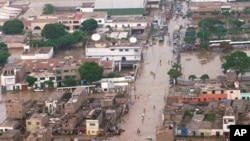The heaviest rains and hottest temperatures in two decades have battered Peru over the past week as weather linked to El Nino caused flooding and landslides that blocked the country's central highway and forced scores from their homes.
At least five people have died in weather-related accidents since Monday, including four trapped in an unregulated mining pit, said Miguel Yamasaki, an official with state civil defense institute, Indeci.
Peru's weather agency, Senamhi, put the country on alert for even more intense rains the rest of the week after downpours overwhelmed towns along the northern coast and in the central Andes and Amazon.
"We haven't seen this volume of rain since 1997" during the last strong El Nino phenomenon, Agriculture Minister Juan Manuel Benites said.
El Nino is a warming of sea-surface temperatures in the Pacific that can intensify rains and cause drought.
Temperatures in several seaside and jungle towns have also reached 20-year highs, said Nelson Quispe, a Senamhi official.
Rivers, roads, exports
Several major rivers already carrying twice as much water as usual threatened to wash over shantytowns built in flood zones along Peru's coast.
This season's El Nino has already left 5,000 homeless and impacted an additional 80,000 people, according to Indeci.
Trucks bringing potatoes, bananas and other goods to Lima remained stranded in the Andes for the fourth day straight as authorities struggled to clear Peru's central highway of debris following a series of landslides and floods.
The highway links a large part of the Andean and Amazonian regions to the capital. Defense Minister Jakke Valakivi urged drivers to make use of shoddy alternate routes and said military planes were only being used to transport people with urgent needs.
Peru would lose about $6 million in exports for every day the central highway remained blocked, according to Peru's export association Adex.
"We've been working hard ... to re-establish transit through the central highway as soon as possible," said Valakivi. "Unfortunately, so far it hasn't been possible."
The disaster will likely squeeze food prices and could stoke inflation that is already near a four-year high. News channel Canal N reported shortages of some products in wholesale markets.
The government deployed mobile clinics after floods shuttered some hospitals. The education minister said officials were evaluating pushing back the start of the school season in some areas.









